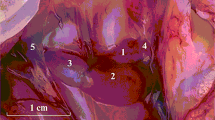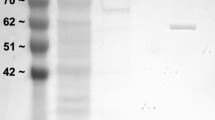Summary
The pressure sensitivities of substrate (pyruvate) and cofactor (NADH) binding and catalytic rate of purified muscle-type (M4) lactate dehydrogenases (LDH, EC 1.1.1.27; NAD+: lactate oxidoreductase) from shallow- and deep-living teleost fishes were compared. The LDH's of the shallow species are significantly more pressure-sensitive than the LDH's of the deep-living fishes. The apparent Michaelis constant (K m)1 of pyruvate of the deep-living species' LDH's is pressure-insensitive over the entire pressure range used in these studies, 1 to 476 atmospheres (Fig. 1). For the LDH's of the shallow species, theK m of pyruvate increases significantly between 1 and 68 atmospheres, and then remains stable up to 476 atmospheres. TheK m of NADH displays a much higher pressure sensitivity. For the LDH's of the deep species, theK m of NADH increases slightly (approximately 32%) between 1 and 68 atmospheres, and then remains stable up to 476 atmospheres (Fig. 1). TheK m of the shallow species' LDH's rises sharply (approximately 113%) between 1 and 68 atmospheres, and then continues to increase at a slower rate up to 476 atmospheres. This marked inhibition of cofactor binding by pressure for the shallow species' LDH's may be of sufficient magnitude to seriously impair the function of these LDH's at pressures typical of those encountered by the deeper-living species.
Pressure effects on optimal velocity, measured under high (optimal) concentrations of pyruvate and NADH, were generally lower for the LDH's of the deep species (Table 1).
These results indicate that M4-LDH's of shallow water fishes are not pre-adapted for function at deepsea pressures, and that the reduction of pressure sensitivities ofK m's and catalysis may be a ubiquitous feature of adaptation to life at depth. The virtually identical pressure responses of M4-LDH's from deepliving teleosts belonging to four different families represents a striking example of convergent evolution at the molecular level.
Similar content being viewed by others
References
Atkinson, D.E.: Adaptations of enzymes for regulation of catalytic function. Biochem. Soc. Symp.41, 205–223 (1976)
Atkinson, D.E.: Cellular energy metabolism and its regulation. New York: Academic Press 1977
Baldwin, J.: Adaptations of enzymes to temperature: acetylcholinesterases in the central nervous system of fishes. Comp. Biochem. Physiol.40B, 181–187 (1971)
Baldwin, J., Storey, K.B., Hochachka, P.W.: Lactate dehydrogenase M4 of an abyssal fish: strategies for function at low temperature and high pressure. Comp. Biochem. Physiol.52B, 19–23 (1975)
Carter, J.V., Knox, D.G., Rosenberg, A.: Pressure effects on folded proteins in solution. Hydrogen exchange at elevated pressures. J. Biol. Chem.253, 1947–1953 (1978)
Dayton, P.K., Hessler, R.R.: Role of biological disturbance in maintaining diversity in the deep sea. Deep-Sea Res.19, 199–208 (1972)
Fairbanks, G., Steck, T.L., Wallach, D.F.H.: Electrophoretic analysis of the major polypeptides of the human erythrocyte membrane. Biochemistry10, 2606–2617 (1971)
Fersht, A.: Enzyme structure and mechanism. San Francisco: Freeman 1977
Grassle, J.F., Sanders, H.L.: Life histories and the role of disturbance. Deep-Sea Res.20, 643–659 (1973)
Hochachka, P.W., Somero, G.N.: Strategies of biochemical adaptation. Philadelphia: W. B. Saunders 1973
Iwamoto, T.: The abyssal fishAntimora rostrata (Günther). Comp. Biochem. Physiol.52B, 7–11 (1975)
Iwamoto, T., Stein, D.L.: A systematic review of rattail fishes (Macrouridae: Gadiformes) from Oregon and adjacent waters. Occasional Papers of the California Academy of Sciences111, 1–79 (1974)
Johnson, F.H., Eyring, H.: The kinetic basis of pressure effects in biology and chemistry. In: High pressure effects on cellular processes. Zimmerman, A.M. (ed.), pp. 1–44. New York: Academic Press 1970
Laemmli, U.K.: Cleavage of structural proteins during the assembly of the head of bacteriophage T4. Nature (Lond.)227, 680–685 (1970)
Laidler, K.J.: The influence of pressure on the rates of biological reactions. Arch. Biochem.30, 226–236 (1951)
Low, P.S., Somero, G.N.: Pressure effects on enzyme structure and functionin vitro and under simulatedin vivo conditions. Comp. Biochem. Physiol.52B, 67–74 (1975)
Macdonald, A.G.: Physiological aspects of deep sea biology. New York: Cambridge University Press 1975
Marquis, R.E., Fenn, W.O.: Dilatometric study of streptococcal growth and metabolism. Can. J. Microbiol.15, 933–940 (1969)
McDowell, S.B.: Order Heteromi (Notochanthiformes). Family Halosauridae. Family Notocanthidae. Family Lipogenyidae. In: Fishes of the western North Atlantic. Mem. Sears Found. Mar. Res.1 (6), 1–228 (1973)
Miller, D.J., Lea, R.N.: Guide to the coastal marine fishes of California. Calif. Dep. Fish Game: Fish Bull.157, 235 pp. (1972)
Moser, H.G.: Development and distribution of juveniles ofSebastolobus (Pisces; Family Scorpaenidae). U.S. Nat. Mar. Fish. Ser. Fishery Bull.72, 865–884 (1974)
Mustafa, T., Moon, T.W., Hochachka, P.W.: Effects of pressure and temperature on the catalytic and regulatory properties of muscle pyruvate kinase from an off-shore benthic fish. Am. Zool.11, 451–466 (1971)
Neuman, R.C., Kauzmann, W., Zipp, A.: Pressure dependence of weak acid ionization in aqueous buffers. J. Phys. Chem.77, 2687–2691 (1973)
Okamura, O.: Marourina (Pisces). Tokyo: Academic Press of Japan 1970
Pearcy, W.G., Ambler, J.W.: Food habits of deep-sea macrourid fishes off the Oregon coast. Deep-Sea Res.21, 745–759 (1974)
Rowe, G.T.: Benthic biomass and surface productivity. In: Fertility of the Sea, Vol. 2. Costlow, J.D. (ed.), pp. 441–454. New York: Gordon and Breach 1971
Rowe, G.T., Menzel, D.W.: Quantitative benthic samples from the deep Gulf of Mexico with some comments of the measurement of deep-sea biomass. Bull. Mar. Sci.21, 556–566 (1971)
Schmid, G., Lüdemann, H.-D., Jaenicke, R.: Oxidation of sulfhydryl groups in lactate dehydrogenase under high hydrostatic pressure. Eur. J. Biochem.86, 219–224 (1977)
Siebenaller, J.F.: Genetic variability in deep-sea fishes of the genusSebastolobus (Scorpaenidae). In: Marine organisms: genetics ecology and evolution, Battaglia, B., Beardmore, J.A. (eds.). pp. 95–122. New York: Plenum Press 1978
Siebenaller, J., Somero, G.N.: Pressure-adaptive differences in lactate dehydrogenases of congeneric fishes living at different depths. Science (New York)201, 255–257 (1978)
Somero, G.N.: Temperature as a selective factor in protein evolution: the adaptational strategy of “compromise”. J. Exp. Zool.194, 175–188 (1975)
Somero, G.N.: Temperature adaptation of enzymes: Biological optimization through structure-function compromises. Ann. Rev. Ecol. System.9, 1–29 (1978)
Somero, G.N., Hochachka, P.W.: Biochemical adaptations to pressure. In: Adaptation to environment: essays on the physiology of marine animals. Newell, R.C. (ed.), pp. 480–510. London: Butterworth 1976
Somero, G.N., Low, P.S.: Eurytolerant proteins: mechanisms for extending the environmental tolerance range of enzyme-ligand interactions. Am. Natur.111, 527–538 (1977)
Wenner, C.A., Musick, J.A.: Biology of the morid fish,Antimora rostrata, in the western North Atlantic. J. Fish. Res. Board Can.34, 2362–2368 (1977)
Whitt, G.S., Prosser, C.L.: Lactate dehydrogenase isozymes, cytochrome oxidase activity, and muscle ions of the rattail (Coryphaenoides sp.). Am. Zool.11, 503–511 (1971)
Wilkinson, G.N.: Statistical estimations in enzyme kinetics. Biochem. J.80, 324–334 (1961)
Wohlschlag, D.E.: Respiratory metabolism and ecological characteristics of some fishes in McMurdo Sound, Antarctica. In: Biology of the Antarctic Seas, Vol. 1, Antarctic Research Series. Lee, M.O. (ed.), pp. 33–62. Baltimore: American Geophysical Union 1964
Yancey, P.H., Somero, G.N.: Temperature dependence of intracellular pH: its role in the conservation of pyruvate apparent Km values of vertebrate lactate dehydrogenases. J. comp. Physiol.125, 129–134 (1978a)
Yancey, P.H., Somero, G.N.: Urea-requiring lactate dehydrogenases of marine elasmobranch fishes. J. comp. Physiol.125, 135–141 (1978b)
Author information
Authors and Affiliations
Rights and permissions
About this article
Cite this article
Siebenaller, J.F., Somero, G.N. Pressure-adaptive differences in the binding and catalytic properties of muscle-type (M4) lactate dehydrogenases of shallow- and deep-living marine fishes. J Comp Physiol B 129, 295–300 (1979). https://doi.org/10.1007/BF00686984
Accepted:
Issue Date:
DOI: https://doi.org/10.1007/BF00686984




